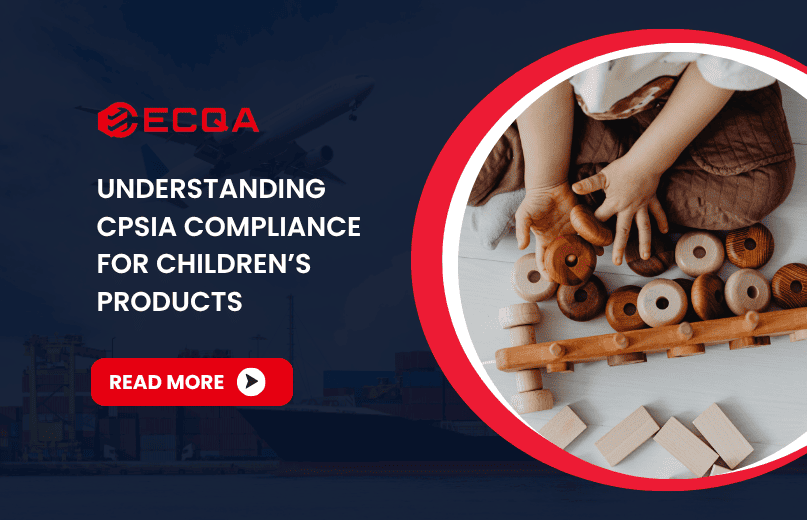
Understanding CPSIA Compliance for Children’s Products
The Consumer Product Safety Improvement Act (CPSIA) is a landmark U.S. federal law enacted in 2008 to ensure the safety of children’s products sold in the United States. It was introduced in response to a series of high-profile recalls, particularly of toys containing hazardous lead levels and other dangerous materials.
CPSIA established strict safety standards, mandatory testing requirements, and certification obligations aimed at reducing risks of injury, illness, or death from unsafe consumer goods intended for children.

Under CPSIA, any product designed or intended primarily for children aged 12 and under must comply with specific safety rules covering chemical content, mechanical hazards, labeling, and traceability.
The act is enforced by the Consumer Product Safety Commission (CPSC), an independent U.S. government agency with broad authority to oversee, inspect, investigate, and enforce product safety compliance.
Scope of CPSIA: Which Products Are Covered
CPSIA applies to a wide range of consumer goods, but its focus is clear: protecting children aged 12 and under from unsafe products. This age cutoff is strict. If a product is designed or marketed primarily for this age group, it falls under CPSIA’s jurisdiction.
Defining “Children’s Product”
According to the CPSC, a product is classified as a children’s product if it’s primarily intended for use by children 12 years old or younger, based on:
- The manufacturer’s stated intent (labeling, marketing, packaging)
- The product’s features (size, colors, graphics)
- How it’s typically used
- The likelihood of its use by children
Even if not labeled as a children’s product, an item may still legally qualify as one based on these factors and must meet all compliance obligations.
Age Group Applicability: The 12-and-Under Rule
Products designed for any of these age groups must comply:
- 0–3 years (infants/toddlers) – Highest risk group; subject to the strictest safety requirements
- 4–7 years (young children) – Still vulnerable to choking hazards, toxins, and flammable materials
- 8–12 years (older children) – Often use more complex products but remain covered under CPSIA
Products aimed at teens or general-use may fall outside CPSIA, but gray areas exist. The CPSC closely evaluates borderline cases.
Common Examples of CPSIA-Regulated Children’s Products
Toys
From plush dolls to plastic cars, toys must meet strict mechanical, chemical, and flammability standards. Most require third-party testing and a Children’s Product Certificate (CPC) before entering the U.S. market.
Children’s Apparel
Clothing for children under 12 must comply with flammability limits, lead content thresholds, and tracking label rules. Specific requirements apply to drawstrings in jackets and hoodies, due to strangulation risks.
School Supplies
Crayons, markers, rulers, pencil cases, and backpacks intended for school-aged children fall under CPSIA. These products often contain plastics, inks, coatings, or dyes all of which must be tested for lead and phthalates.
Children’s Furniture and Cribs
Items like cribs, high chairs, toddler beds, and booster seats are regulated under both CPSIA and the Danny Keysar Child Product Safety Notification Act. Cribs must also meet specific design and durability standards under 16 CFR 1219 and 1220, and include registration cards for recall traceability.
Electronics for Children
Products such as tablets, learning consoles, and battery-powered toys must pass CPSIA testing for lead, phthalates, and button battery safety, along with additional rules for cord length, surface temperature, and sharp components.
Key CPSIA Requirements Every Business Must Follow
To legally sell children’s products in the US., businesses must comply with CPSIA’s core safety requirements. These cover chemical safety, mechanical integrity, labeling, traceability, and documentation. Failure to meet them can result in recalls, customs seizure, fines, or legal action.
1. Lead Content Limits
CPSIA restricts lead to:
- 100 ppm for substrate materials (e.g., plastic, metal, fabric base layers)
- 90 ppm for surface coatings (e.g., paint, inks, varnishes)
This applies to every accessible component of a children’s product including zippers, snaps, buttons, coated fabrics, and decals. All must be tested by a CPSC-accepted lab.
2. Phthalates Restrictions
Phthalates are chemicals used to soften plastics. CPSIA prohibits the use of the following phthalates in accessible components of children’s toys and childcare articles at concentrations greater than 0.1% (1,000 ppm):
- Di-(2-ethylhexyl) phthalate (DEHP)
- Dibutyl phthalate (DBP)
- Benzyl butyl phthalate (BBP)
- Diisononyl phthalate (DINP)
- Diisobutyl phthalate (DIBP)
- Di-n-pentyl phthalate (DPENP)
- Di-n-hexyl phthalate (DHEXP)
- Dicyclohexyl phthalate (DCHP)
These are commonly found in soft plastic items like teething rings, inflatable toys, and PVC components. Only materials certified as phthalate-free should be used.
3. Small Parts Regulations
Any component that fits entirely into a small parts cylinder is a potential choking hazard for children under 3. Such parts are prohibited unless the product is for older children and clearly labeled with a choking warning.
Mechanical tests must confirm that no part can detach during use or foreseeable abuse.
4. Sharp Points and Edges
Children’s products must not have sharp edges or points that could cut or puncture skin. Common violations include:
- Metal corners
- Sharp plastic seams
- Poorly secured hardware
- Breakable parts
Infant and toddler products are subject to stricter mechanical safety rules under 16 CFR 1500.48–49.
5. Flammability Standards
Children’s sleepwear, bedding, tents, and other textiles must meet strict flammability standards. Sleepwear must either be:
- Tight-fitting (exempt), or
- Flame-resistant per 16 CFR 1615/1616
6. Tracking Labels
All children’s products must carry permanently affixed tracking labels with:
- Manufacturer name
- Date and location of production
- Batch or lot number
- Other traceable identifiers
This applies to both the product and its packaging. Labels must be visible and accessible to consumers, aiding in recall effectiveness and regulatory compliance.
CPSIA is a legal obligation and a critical part of building trust in any children’s brand. From lead limits and phthalates bans to small parts testing and traceability, compliance protects both your business and the children who use your products.
If you design, import, or sell products for kids 12 and under, now is the time to act. Review every item in your catalog, test every material through CPSC-accredited labs, and document every compliance step. Because when it comes to children’s safety, there is no margin for error.
Related Article:
EN17 Toy Safety Guide
How to Ensure toy safety compliance for international markets
Toy Lab Testing in China
Toy Inspection
Toy Quality Control

 Request Free Sample Report
Request Free Sample Report